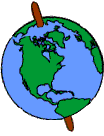|
 The
Tilt of Earth's Axis The
Tilt of Earth's Axis
The second orbital
change Milankovich studied is the tilt of Earth's axis relative
to its orbit around the Sun. The tilt of Earth's axis is the main
cause of the seasons. If Earth had no tilt, then the length of daylight
and the intensity of solar heating seen by a person standing at
a single place on the surface would be the same all year round.
The area near Earth's equator would still be hotter than the area
around the poles, but there would be no seasonal changes in temperature:
the Equator would always be hot, the poles would always be cold,
and the US would always be blah!

But Earth does have a
tilt, so on one side of the orbit, the Northern hemisphere is pointed
more directly towards the Sun (as seen on the left side of the picture
above). On the other side of the orbit, six months later, it is
pointed more away from the Sun (as seen on the right side of the
picture above). When the Northern hemisphere is pointed towards
the Sun, the days are longer, solar heating is more intense, and
temperatures are higher - it is summertime! When the Northern hemisphere
is pointed away from the sun, the days are shorter, solar heating
less intense, and the temperatures are lower - it is winter! (Notice
that when the Northern hemisphere is pointed toward the Sun, the
Southern hemisphere is pointed away, and vice versa. So when it
is summer in the north, it is winter in the south and vice versa.)
Milankovich found that
Earth's tilt is not constant, but varies slightly over a cycle that
lasts about 41,000 years. The change is small, but when the tilt
is less, less snow melts in the polar regions because of the shorter
days and reduced sunlight, allowing glaciers to form and spread.
When the tilt is greater, more snow melts during the resulting long
summers in the polar regions and glaciers tend to shrink.
Back
| Next
|











